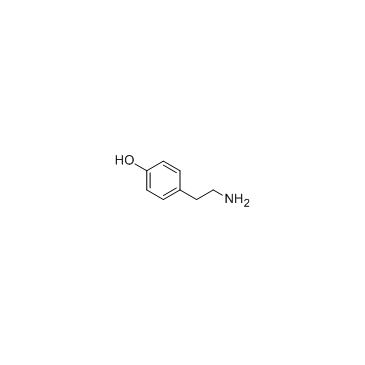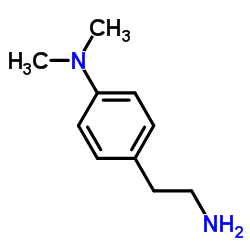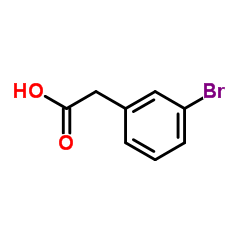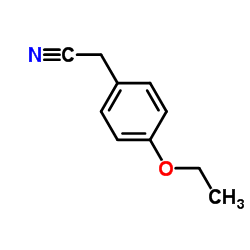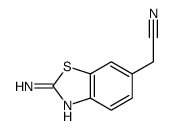3544-25-0
| 中文名 | 对氨基苯乙腈 |
|---|---|
| 英文名 | 2-(4-aminophenyl)acetonitrile |
| 中文别名 |
4-氨基苯乙腈
對胺苯乙腈 4-氨基苄氰 |
| 英文别名 |
(4-Aminophenyl)acetonitrile
4-aminophenylacetic acid nitrile p-Aminobenzyl cyanide p-aminophenyl-acetonitrile 4-aminophenylacetonitrile p-cyanomethylphenyl amine 4-aminobenzyl 4-aminobenzeneacetonitrile (p-Aminophenyl)acetonitrile 2-(4-Aminophenyl)acetonitrile MFCD00007912 4-Aminobenzyl cyanide EINECS 222-587-4 p-amino benzyl cyanide Benzeneacetonitrile, 4-amino- |
| 密度 | 1.1±0.1 g/cm3 |
|---|---|
| 沸点 | 312.0±0.0 °C at 760 mmHg |
| 熔点 | 45-48 °C(lit.) |
| 分子式 | C8H8N2 |
| 分子量 | 132.163 |
| 闪点 | 136.3±20.9 °C |
| 精确质量 | 132.068741 |
| PSA | 49.81000 |
| LogP | 0.17 |
| 外观性状 | 淡黄色晶体 |
| 蒸汽压 | 0.0±0.6 mmHg at 25°C |
| 折射率 | 1.593 |
| 储存条件 | 常温,避光,通风干燥处,密封保存 |
| 稳定性 | 常温常压下稳定,白色或淡黄色结晶 |
| 水溶解性 | SLIGHTLY SOLUBLE |
| 分子结构 | 1、 摩尔折射率:39.95 2、 摩尔体积(m3/mol):117.9 3、 等张比容(90.2K):317.9 4、 表面张力(dyne/cm):52.8 5、 极化率(10 -24cm 3):15.83 |
| 计算化学 | 1.疏水参数计算参考值(XlogP):无 2.氢键供体数量:1 3.氢键受体数量:2 4.可旋转化学键数量:1 5.互变异构体数量:无 6.拓扑分子极性表面积49.8 7.重原子数量:10 8.表面电荷:0 9.复杂度:137 10.同位素原子数量:0 11.确定原子立构中心数量:0 12.不确定原子立构中心数量:0 13.确定化学键立构中心数量:0 14.不确定化学键立构中心数量:0 15.共价键单元数量:1 |
| 更多 | 1. 性状:棕色晶体状粉末 2. 密度(g/mL,25/4℃):未确定 3. 相对蒸汽密度(g/mL,空气=1):未确定 4. 熔点(ºC):42-46 5. 沸点(ºC,常压):312 6. 沸点(ºC,5.2kPa):未确定 7. 折射率:未确定 8. 闪点(ºC):未确定 9. 比旋光度(º):未确定 10. 自燃点或引燃温度(ºC):>110 11. 蒸气压(kPa,25ºC):未确定 12. 饱和蒸气压(kPa,60ºC):未确定 13. 燃烧热(KJ/mol):未确定 14. 临界温度(ºC):未确定 15. 临界压力(KPa):未确定 16. 油水(辛醇/水)分配系数的对数值:未确定 17. 爆炸上限(%,V/V):未确定 18. 爆炸下限(%,V/V):未确定 19. 溶解性:稍微可溶解的 |
Synonym:4-Aminophenylacetonitrile; 4-Aminobenzyl cyanide Section 2 - COMPOSITION, INFORMATION ON INGREDIENTS
Risk Phrases: 20/21/22 Section 3 - HAZARDS IDENTIFICATION EMERGENCY OVERVIEW
Harmful by inhalation, in contact with skin and if swallowed. Potential Health Effects Eye: May cause eye irritation. Skin: May cause skin irritation. May be harmful if absorbed through the skin. Ingestion: May cause gastrointestinal irritation with nausea, vomiting and diarrhea. May be harmful if swallowed. Inhalation: May cause respiratory tract irritation. May be harmful if inhaled. Chronic: May be metabolized to cyanide which in turn acts by inhibiting cytochrome oxidase impairing cellular respiration. Chronic exposure to cyanide solutions may lead to the development of a "cyanide" rash, characterized by itching, and by macular, papular, and vesicular eruptions, and may be accompanied by secondary infections. Exposure to small amounts of cyanide compounds over long periods of time is reported to cause loss of appetite, headache, weakness, nausea, dizziness, and symptoms of irritation of the upper respiratory tract and eyes. Section 4 - FIRST AID MEASURES Eyes: In case of contact, immediately flush eyes with plenty of water for at least 15 minutes. Get medical aid. Skin: In case of contact, immediately flush skin with plenty of water for at least 15 minutes while removing contaminated clothing and shoes. Get medical aid immediately. Wash clothing before reuse. Ingestion: If swallowed, do not induce vomiting unless directed to do so by medical personnel. Never give anything by mouth to an unconscious person. Get medical aid. Inhalation: If inhaled, remove to fresh air. If not breathing, give artificial respiration. If breathing is difficult, give oxygen. Get medical aid. Notes to Physician: Section 5 - FIRE FIGHTING MEASURES General Information: As in any fire, wear a self-contained breathing apparatus in pressure-demand, MSHA/NIOSH (approved or equivalent), and full protective gear. Combustion generates toxic fumes. This material in sufficient quantity and reduced particle size is capable of creating a dust explosion. Extinguishing Media: Use water spray, dry chemical, carbon dioxide, or chemical foam. Section 6 - ACCIDENTAL RELEASE MEASURES General Information: Use proper personal protective equipment as indicated in Section 8. Spills/Leaks: Vacuum or sweep up material and place into a suitable disposal container. Clean up spills immediately, observing precautions in the Protective Equipment section. Provide ventilation. Section 7 - HANDLING and STORAGE Handling: Wash thoroughly after handling. Wash hands before eating. Remove contaminated clothing and wash before reuse. Minimize dust generation and accumulation. Avoid contact with eyes, skin, and clothing. Use only with adequate ventilation. Avoid breathing dust. Storage: Store in a tightly closed container. Store in a cool, dry, well-ventilated area away from incompatible substances. Section 8 - EXPOSURE CONTROLS, PERSONAL PROTECTION Engineering Controls: Facilities storing or utilizing this material should be equipped with an eyewash facility and a safety shower. Use adequate ventilation to keep airborne concentrations low. Exposure Limits CAS# 3544-25-0: United States OSHA: 5 mg/m3 TWA (listed under Cyanide anion). Germany: (listed as cyanide anion): Skin absorber Netherlands: (listed as cyanide anion): 5 mg/m3 MAC (as CN) Personal Protective Equipment Eyes: Wear appropriate protective eyeglasses or chemical safety goggles as described by OSHA's eye and face protection regulations in 29 CFR 1910.133 or European Standard EN166. Skin: Wear appropriate protective gloves to prevent skin exposure. Clothing: Wear appropriate protective clothing to prevent skin exposure. Respirators: Follow the OSHA respirator regulations found in 29 CFR 1910.134 or European Standard EN 149. Use a NIOSH/MSHA or European Standard EN 149 approved respirator if exposure limits are exceeded or if irritation or other symptoms are experienced. Section 9 - PHYSICAL AND CHEMICAL PROPERTIES Physical State: Crystalline powder Color: yellow to brown Odor: Not available. pH: Not available. Vapor Pressure: Not available. Viscosity: Not available. Boiling Point: 312 deg C @ 760 mm Hg Freezing/Melting Point: 44-48 deg C Autoignition Temperature: Not available. Flash Point: > 110 deg C (> 230.00 deg F) Explosion Limits, lower: Not available. Explosion Limits, upper: Not available. Decomposition Temperature: Solubility in water: slightly soluble Specific Gravity/Density: Molecular Formula: C8H8N2 Molecular Weight: 132.16 Section 10 - STABILITY AND REACTIVITY Chemical Stability: Stable under normal temperatures and pressures. Conditions to Avoid: Dust generation. Incompatibilities with Other Materials: Strong oxidizing agents, strong reducing agents, strong acids, and strong bases. Hazardous Decomposition Products: Nitrogen oxides, carbon monoxide, carbon dioxide, cyanides. Hazardous Polymerization: Has not been reported. Section 11 - TOXICOLOGICAL INFORMATION RTECS#: CAS# 3544-25-0 unlisted. LD50/LC50: Not available. Carcinogenicity: 4-Aminobenzyl cyanide - Not listed by ACGIH, IARC, or NTP. Section 12 - ECOLOGICAL INFORMATION Ecotoxicity: Bacteria: Phytobacterium phosphoreum: EC50 = 0.36-0.40 mg/L; 5,15,30 minutes; Microtox test; 15 degrees C Section 13 - DISPOSAL CONSIDERATIONS Dispose of in a manner consistent with federal, state, and local regulations. Section 14 - TRANSPORT INFORMATION IATA Shipping Name: NITRILES, SOLID, TOXIC, N.O.S.* Hazard Class: 6.1 UN Number: 3276 Packing Group: III IMO Shipping Name: Nitriles, Toxic, N.O.S. Hazard Class: 6.1 UN Number: 3276 Packing Group: III RID/ADR Shipping Name: Nitriles, Toxic, N.O.S. Hazard Class: 6.1 UN Number: 3276 Packing group: III Section 15 - REGULATORY INFORMATION European/International Regulations European Labeling in Accordance with EC Directives Hazard Symbols: XN Risk Phrases: R 20/21/22 Harmful by inhalation, in contact with skin and if swallowed. Safety Phrases: S 36/37 Wear suitable protective clothing and gloves. WGK (Water Danger/Protection) CAS# 3544-25-0: No information available. Canada None of the chemicals in this product are listed on the DSL/NDSL list. CAS# 3544-25-0 is not listed on Canada's Ingredient Disclosure List. US FEDERAL TSCA CAS# 3544-25-0 is not listed on the TSCA inventory. It is for research and development use only. SECTION 16 - ADDITIONAL INFORMATION N/A |
|
生态学数据: 通常对水是不危害的,若无政府许可,勿将材料排入周围环境
|
| 符号 |

GHS07 |
|---|---|
| 信号词 | Warning |
| 危害声明 | H302-H312-H332 |
| 警示性声明 | P280 |
| 个人防护装备 | dust mask type N95 (US);Eyeshields;Gloves |
| 危害码 (欧洲) | Xn:Harmful; |
| 风险声明 (欧洲) | R20/21/22 |
| 安全声明 (欧洲) | S36-S36/37 |
| 危险品运输编码 | 3276 |
| WGK德国 | 3 |
| 包装等级 | III |
| 危险类别 | 6.1 |
| 海关编码 | 2926909090 |
| 上游产品 6 | |
|---|---|
| 下游产品 10 | |
| 海关编码 | 2926909090 |
|---|---|
| 中文概述 | 2926909090 其他腈基化合物. 增值税率:17.0% 退税率:9.0% 监管条件:无 最惠国关税:6.5% 普通关税:30.0% |
| 申报要素 | 品名, 成分含量, 用途 |
| Summary | HS:2926909090 other nitrile-function compounds VAT:17.0% Tax rebate rate:9.0% Supervision conditions:none MFN tariff:6.5% General tariff:30.0% |



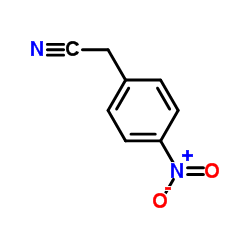

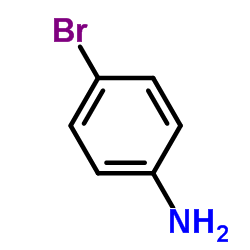


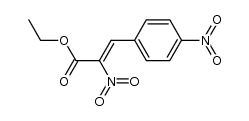


![N-[4-(2,4,7-triaminopteridin-6-yl)phenyl]methanesulfonamide结构式](https://image.chemsrc.com/caspic/433/142731-14-4.png)
